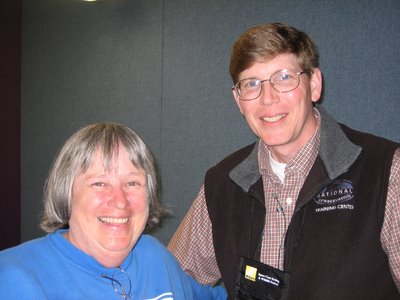Space Coast: Scott Weidensaul
Writer, bird bander and naturalist Scott Weidensaul presented the keynote on Saturday evening. His attention-grabbing talk, "Return to Wild America," included images from his 2003 trip around North America that replicated the path taken by Roger Tory Peterson and James Fisher in 1953.
Weidensaul said friends and colleagues warned him that his trip would depress him because of unfortunate changes to the habitat in the last 50 years. Instead, he said, "I came away incredibly energized and incredibly optimistic."
In 1953, little to no protections were in place for the environment and wildlife. In the intervening years, many steps have been taken to conserve and preserve the natural world. "Wild America is still out there," Weidensaul said.
Citing such instances as the return of Wild Turkeys to New York's Manhattan Island and the success of Grupo Ecologicao Sierra Gorda in Mexico, Weidensaul painted a positive picture. He didn't, however, neglect the challenges that face locations such as Florida's Dry Tortugas or the Everglades, where wading bird populations have declined 90 to 95 percent since 1953, as well as Alaska's Yukon Delta, where the rising Bering Sea now floods out the birds' nests every other year rather than every 10 to 15 years.
Weidensaul finished his journey in Alaska's Pribilof Islands on St. George Island, where he savored "a glimpse of an older and more complete world" that included "clouds of auklets and murres." The naturalist remains optimistic about the presence of open habitat and wildlife in North America. Citing the progress since 1953 in protecting natural resources and re-introducing species, he said, "We can do far more than we think we can, and we are responsible for dreaming big dreams."
Festival founder Laurilee Thompson introduced Weidensaul.
Weidensaul said friends and colleagues warned him that his trip would depress him because of unfortunate changes to the habitat in the last 50 years. Instead, he said, "I came away incredibly energized and incredibly optimistic."
In 1953, little to no protections were in place for the environment and wildlife. In the intervening years, many steps have been taken to conserve and preserve the natural world. "Wild America is still out there," Weidensaul said.
Citing such instances as the return of Wild Turkeys to New York's Manhattan Island and the success of Grupo Ecologicao Sierra Gorda in Mexico, Weidensaul painted a positive picture. He didn't, however, neglect the challenges that face locations such as Florida's Dry Tortugas or the Everglades, where wading bird populations have declined 90 to 95 percent since 1953, as well as Alaska's Yukon Delta, where the rising Bering Sea now floods out the birds' nests every other year rather than every 10 to 15 years.
Weidensaul finished his journey in Alaska's Pribilof Islands on St. George Island, where he savored "a glimpse of an older and more complete world" that included "clouds of auklets and murres." The naturalist remains optimistic about the presence of open habitat and wildlife in North America. Citing the progress since 1953 in protecting natural resources and re-introducing species, he said, "We can do far more than we think we can, and we are responsible for dreaming big dreams."



0 Comments:
Post a Comment
<< Home